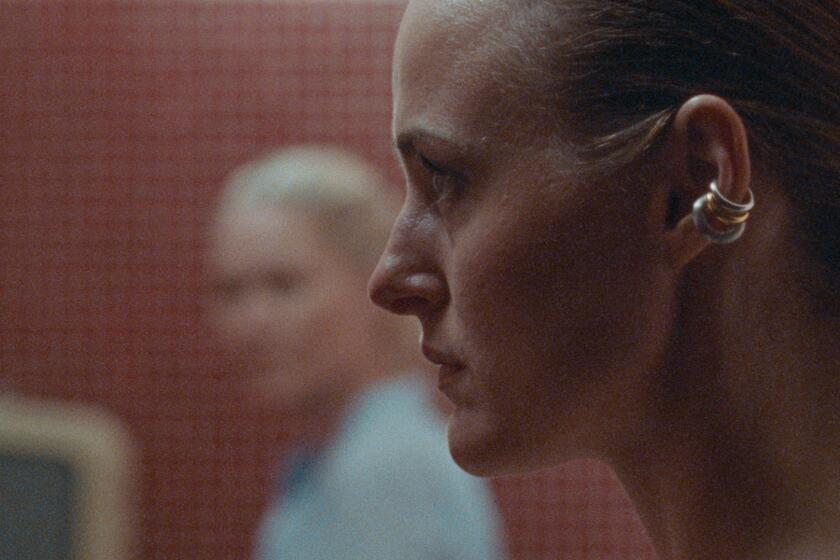Actors navigate public’s matrix
- Share via
We are watching a lithe, beautiful assassin packing serious heat and a supreme sense of cool as she teaches a nervous young man how to shoot. The confident assassin, named Fox, embodies all that is predatory, ruthless and lethally sexy.
But as we watch Fox, the antiheroine of last summer’s hyper-violent action flick “Wanted,” we are also watching Angelina Jolie, whose off-screen persona as humanitarian activist and mother is every bit as strong as the fictional one. And the ability of viewers to accept those two ideas simultaneously turns out to be crucial to the audience’s satisfaction and the film’s success. As Fox ruthlessly dispatches bad guys from screeching cars or speeding trains, it doesn’t matter that we might have recently seen the woman playing her speaking at the Council on Foreign Relations or taking her children to school.
Bloodthirsty killer or global humanitarian? Clearly, when it comes to Jolie, we’ll take both.
The matrix of stardom is that mental space we navigate every time we encounter our biggest stars on the screen. These are stars of megawattage, actors who despite their acting talents are long past being able to melt anonymously into their roles. They are the superstars whose off-screen lives we follow in an ongoing narrative that can be every bit as riveting as their movies.
That ongoing “real-life” narrative forms one of the struts of the stardom matrix, which is propped up by a delicate balance among the stars’ off-screen identities, their on-screen characters and the audience’s projections. The question isn’t whether we can forget we’re watching a particular actor but whether we can somehow hold in our minds that we are watching that actor, and still believe in the character.
(No, this isn’t the same as typecasting. The matrix allows for casting against type, often with delightful results. And yes, the matrix is like “The Matrix,” to a point -- the subliminal way we apprehend competing or complementary personas.)
To consider the past year in movies is to behold fascinating, in some cases cautionary examples of the matrix of stardom. Why did we accept Jolie in “Wanted” but not “Changeling”? Why did Robert Downey Jr. triumph when Nicole Kidman failed? How is Brad Pitt managing his matrix in “The Curious Case of Benjamin Button”? How is Clint Eastwood going meta with the matrix in “Gran Torino”?
And can Tom Cruise’s matrix be saved?
The matrix is strongest when the stars’ fictional characters harmonize with their off-screen selves that we think we know from their public appearances and interviews. That’s why Jolie’s matrix operated so smoothly in “Wanted,” where her tough on-screen character jibed with the bad-girl persona of her Lara Croft and Billy Bob Thornton days.
But we didn’t buy “Changeling,” in which Jolie played a real-life woman whose son was kidnapped and murdered, and who was forced by police to accept an impostor as her little boy. Though her performance was lauded, audiences have largely stayed away. Why? She’s simply too strong for us to believe her as meek and mousy.
Viewers loved “Iron Man” in part because Downey, whose battles with drug addiction had become the stuff of tabloid fodder, so deftly addressed and dispelled our images of him.
In the Hollywood parody “Tropic Thunder,” Downey’s playfully self-referential performance as a super-Method actor poked fun at his vaunted reputation. The punch line, of course, was that Downey was genuinely good as a pompous actor.
It’s still questionable whether Cruise will succeed in reinventing his matrix, with the audience’s still-vivid memories of bizarre appearances with Oprah Winfrey and the “Today” show’s Matt Lauer. Cruise confronted audience hostility head-on in his virtually unrecognizable cameo in “Tropic Thunder.” Fat, bald, bespectacled, Cruise presented a loathsome physical and moral specimen as a movie mogul, and the gambit worked. But “Tropic Thunder” was really just softening up audiences to accept Cruise in his most crucial role this year, in “Valkyrie,” about a plot to assassinate Hitler. Cruise plays a courageous German military man, the kind of heroic role that viewers once would have accepted him in without hesitation. Now that he’s done parodic penance in “Tropic Thunder,” now that he’s apologized to Lauer, the only question is whether filmgoers will be able to enter Cruise’s matrix with confidence one more time.
One star who’s done some fascinating preemptive work on his matrix is Brad Pitt, playing a man who ages backward in “Benjamin Button.” As if to anticipate the day when his fans won’t forgive him for getting older, Pitt presents that image to them now, via prosthetics and makeup, so they can get used to it. And as he gets younger, Pitt, 45, slyly reminds them of the golden boy in “Thelma & Louise.”
Pitt also manages to quietly tweak the off-screen story that has threatened to define him since his 2005 divorce from Jennifer Aniston. Like all stars within the matrix, Pitt has created a character of himself in “real life,” a character that, while not entirely fictional, is every bit as manufactured for public consumption.
More to Read
Only good movies
Get the Indie Focus newsletter, Mark Olsen's weekly guide to the world of cinema.
You may occasionally receive promotional content from the Los Angeles Times.










